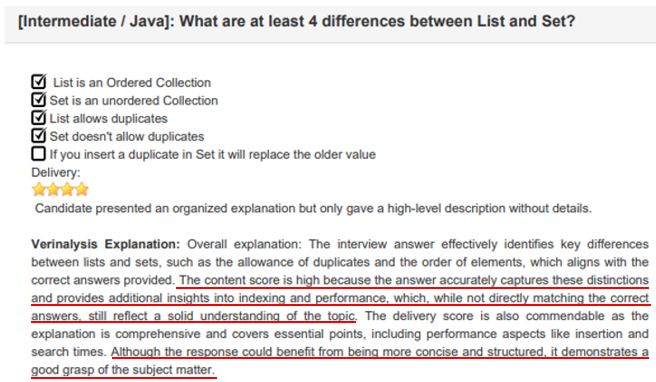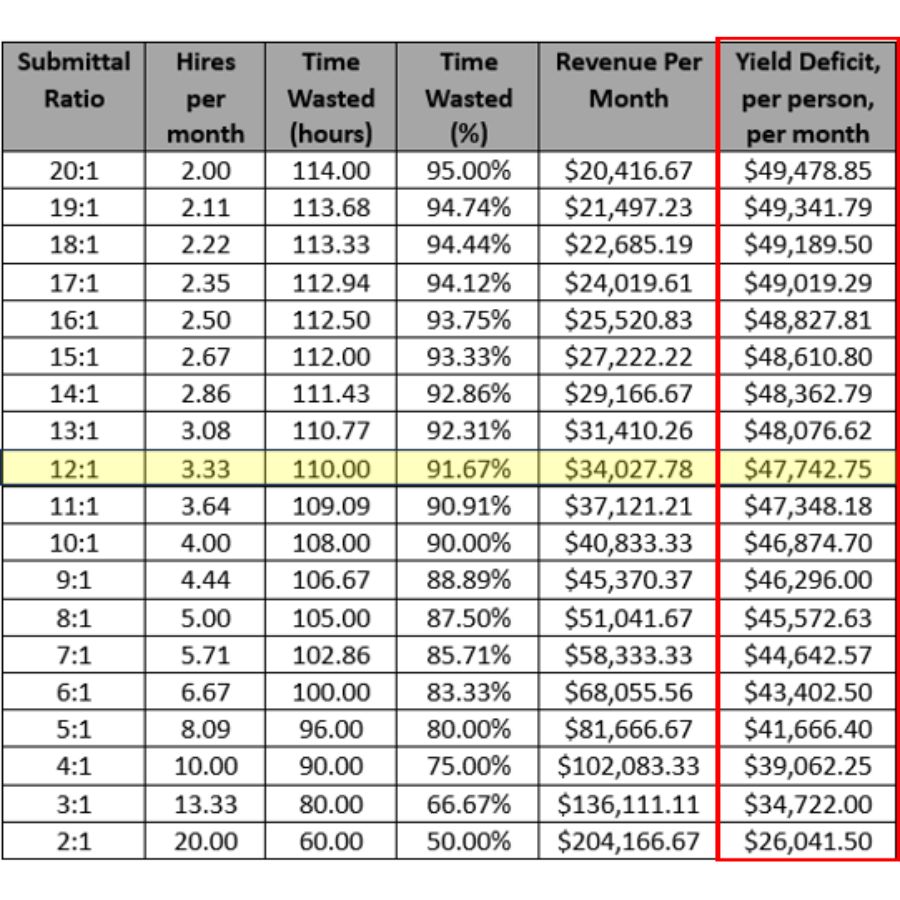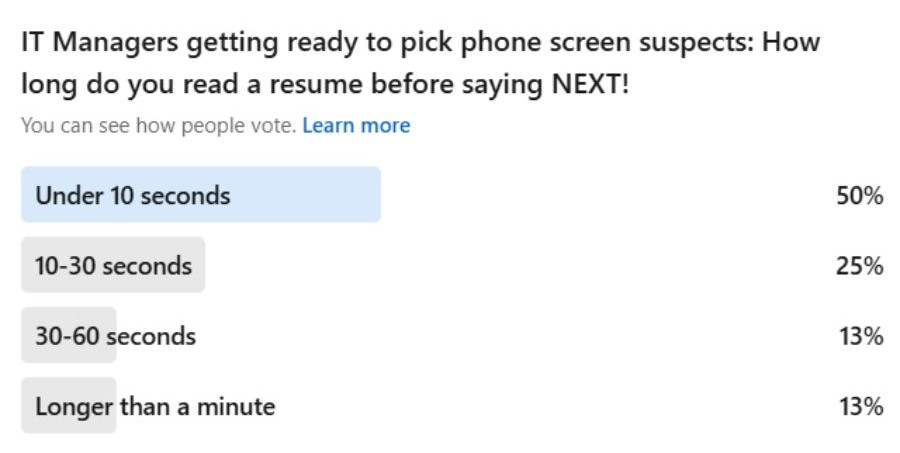IT Hiring's Single Point of Failure: Manager Reading a Resume
No one gets hired before a manager reads a resume, which is actually undermining the IT hiring process.
IT Managers are the single point of failure in the hiring process, but no one has recognized this.
If that seems like the definition of a paradox, you are exactly right. We are just going to shine a spotlight on it.
There is a galaxy of AI-powered HR Tech tools that are not solving the industry’s primary problem: IT Managers read resumes with an objective to reject them as fast as possible. These rejections are largely based on a buzzword-reading blitz that have little (or nothing) to do with the carefully written capsules recruiters create in presenting candidates to managers.
We recently conducted a poll on LinkedIn (shown above) asking IT managers how quickly they scan a resume before saying ‘NEXT!’. We all suspected that it was pretty quick, but seeing the actual numbers was stunning:
- 75% of all candidates get rejected inside of 30 seconds
- 50% are shot down inside of 10 seconds
Anyone with Staffing experience would have bet a lot of cash that managers read resumes very quickly. I have asked dozens of industry peers the same question and 100% of them were completely aligned with our data. Our poll just proved it mathematically.
IT managers make every other decision on the job with evidence. They need to be able to measure, recreate or test something to make a confident decision when it comes to deploying code. Resumes force Managers to make educated guesses because there is no hard evidence of a candidate’s competence or insight. Managers are forced to rely on buzzwords because so few HR Tech solutions try to present evidence of the candidate’s knowledge as they review the resumes. There is no other time the recruiter can influence the manager.
Coding exercises are increasingly driving candidates away and chatbots that do interviews are mocked by developers. Our AI Verify offers recruiters an immersive experiential learning session and gives their candidate an exponentially better chance of being selected for an interview by the manager compared to the buzzword approach.
AI Verify operates like a co-pilot for the Recruiter, who creates an interview (pre-built or custom) out of a library that has 140 IT skills and asks the questions presented on the screen. AI Verify then does a deep and accurate analysis of the candidate’s performance in the interview in a detailed report to give the manager critical evidence in this tiny shard of time. You have one chance to influence the manager inside of a window that stays open between 5 and 60 seconds. If you send nothing but a resume, you are forfeiting your only chance to influence the manager.
Research firms like the TechServe Alliance track the IT Staffing industry and publish annual operational reports on the KPIs generated by their members. An average year shows that it takes between 11 and 13 submittals for one person to get hired, but we really need to dig into the numbers to reveal their hidden implications and how it reflects on the entire IT Recruiting industry, in general, and IT Staffing, in particular.
We would like to illustrate the gravity of a 13:1 sub-to-start for hundreds of TechServe members, so we will make some assumptions about the submittal numbers in the TechServe report.
- There are 450 TechServe member firms who contributed to the report
- Each firm has an average of 5 recruiters
- The Recruiters average 40 submittals a month
Those statistics show a staggering lack of accuracy that burns massive amounts of productive time:
450 Firms x 5 recruiters = 2,250 total recruiters
2,250 recruiters x 40 submittals/mo. = 90,000 submittals/mo.
90,000 subs per month = 1,080,000 total annual submittals
13:1 sub-to-start = 0.0769% hit rate or 996,923 rejected candidates
996,923 rejections = Recruiters burned nearly 92% of the time it took to make submittals
Recruiters may not be technical, but they jealously guard their time and are money motivated. There is absolutely no way that 2,250 recruiters could be dead wrong in submitting 1.08 million candidates and having 993,600 of them rejected for being unqualified.
It defies the laws of probability and it also perfectly explains how so many submittals were rejected. The managers are reviewing 75% of those 1.08 million candidates in under 30 seconds; 540,000 subs were shredded in under 10 seconds. It is physically impossible for a manager to review that many candidates if they were extracting any insight of the candidate’s capabilities. A rapid-fire buzzword scan is the only explanation.
Let this sink in: The entire IT Staffing industry relies on a model where a candidate being selected for a phone screen has the same odds as drawing an ace from a deck of cards in one attempt.
Recruiters will always need to send a resume, but our clients will use AI Verify to send a Verinalysis – which stands for AI-Verified Analysis – report that provides a deep, accurate analysis of the candidate’s performance in an interview. These time-torching numbers will never change unless managers can consider relevant information about the candidate’s competence in parallel with reviewing the resume.
These historically poor submittal numbers don’t stand out because they have always been this poor. The sub-to-start numbers have been so historically low that no one has ever stopped to ask ‘Why?’ or ‘How can we improve these numbers?’ I think there would be more concern, urgency or outrage if someone actually counted the money needlessly lit on fire by woefully inefficient and unfair processes in hiring IT candidates.

TechScreen has uncovered astonishing levels of inefficiency in the IT Recruiting industry since it became a standalone vertical around 1960. Staffing firms have suffered dismal profit margins (4-5%) when compared to many other sectors in the services industry (20-50%). This 3-part blog series goes into substantial details that shows the history of how this evolved, but the takeaway is concrete: Staffing firms will knowingly torch over 90% of the time it takes recruiters to produce submittals if they don’t start influencing the manager as they are reviewing candidates. They just didn’t know the numbers before now.
TechScreen is going to help usher in a new approach to presenting candidates so they get an evidence-based evaluation to move forward in the process. We created a new kind of KPI called the Yield Deficit, which is the other side of the coin from the sub-to-start KPI. The Yield Deficit gives a true accounting as to how much money is being burned to conduct activities that produce no revenue.
The chart below captures the raw dollars being burned when the manager is left to apply their resume-razing methodology to normal candidate review. You are staring at the reason the IT Staffing industry has had historically low profit margins. TechServe’s OPR reports provide the raw KPIs being generated in the industry, but we are uncovering the reasons those numbers persist and how dramatically they are dragging down profitability.

IT Staffing has survived for decades because topline revenue has always been so robust. Statista reported that US contract staffing revenue was $142B in 2023, which is actually down 17% from $171 Billion 2022. This encompasses all verticals within staffing, but IT is the largest market segment by far.
The Staffing industry has needlessly suffered low profits and high attrition for its entire history. Now we know the reasons and the impact it has had, along with a feasible solution. It is our responsibility to spread the seeds of knowledge to reverse this catastrophic industry trend.
About TechScreen
TechScreen was created based on the idea there was a problem with properly vetting technical candidates. TechScreen, powered by AI Verify, is the world’s only SaaS product that lets a recruiter or hiring team conduct a detailed interview of an IT candidate without truly knowing the underlying content. Each candidate is also evaluated and scored by our artificial intelligence. While also providing a detailed write-up to share with your client to prove the quality of your technical screening.

